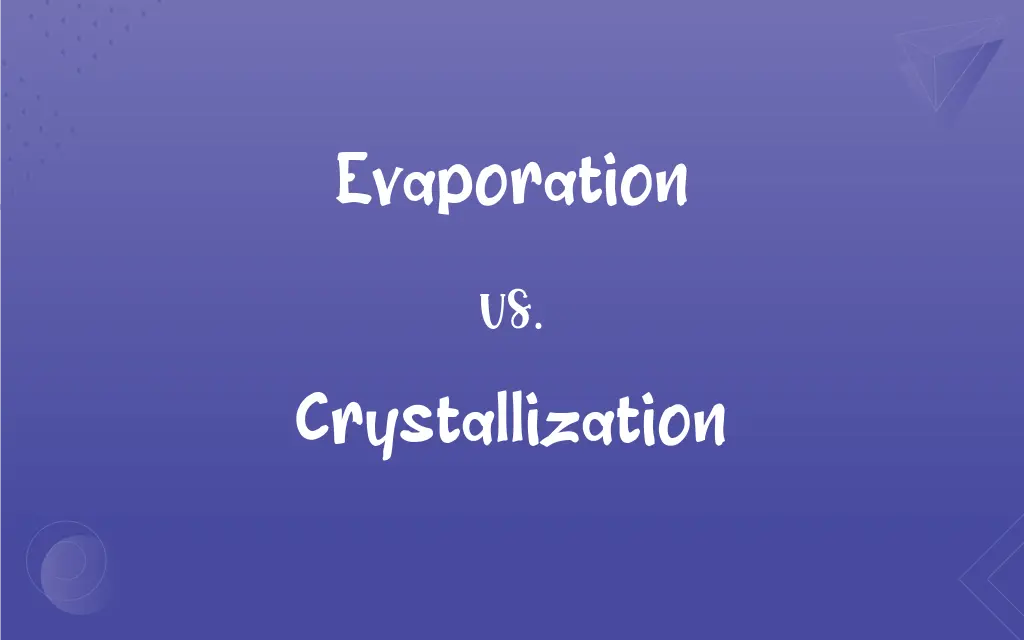Evaporation vs. Crystallization: What's the Difference?
Edited by Aimie Carlson || By Harlon Moss || Published on February 24, 2024
Evaporation is the process of a liquid turning into vapor, while crystallization is the process of forming solid crystals from a solution or melt.

Key Differences
Evaporation involves the transition of a substance from the liquid phase to the gaseous phase, typically under the influence of temperature. Crystallization, however, is the process where a solid crystal form emerges from either a liquid or gaseous solution. While evaporation results in the loss of liquid as it becomes vapor, crystallization results in the formation of solid structures from a solution.
Evaporation is driven by temperature and occurs when molecules in a liquid gain enough energy to escape into the gas phase. Crystallization can occur either through cooling a liquid until it solidifies or through the evaporation of a solvent in a solution. Evaporation is a key part of the water cycle, whereas crystallization is crucial in various industrial processes, including the purification of compounds.
Evaporation usually leads to cooling of the liquid left behind, as it involves the loss of high-energy molecules. Crystallization, on the other hand, often involves the release of energy in the form of heat. Evaporation is a surface phenomenon, whereas crystallization can occur throughout the volume of the liquid as it forms a solid phase.
Evaporation does not necessarily change the chemical composition of the substance, merely its state. In crystallization, there is often a change in the physical arrangement of molecules, leading to a new structure. Evaporation is commonly observed in daily life through drying of water, while crystallization is observed in the formation of snowflakes, salt from seawater, and in sugar processing.
Rate of evaporation is influenced by factors like temperature, surface area, and air movement. Crystallization's rate and the quality of crystals formed can be influenced by factors such as temperature, concentration of the solution, and presence of impurities. Both processes are essential in scientific and industrial applications, but their roles and mechanisms are distinct.
ADVERTISEMENT
Comparison Chart
Process
Transition from liquid to gas
Formation of solid crystals from a solution or melt
Energy Change
Involves heat absorption
Often releases heat
Result
Loss of liquid as it becomes vapor
Formation of solid crystal structure
Factors Influencing
Temperature, surface area, air movement
Temperature, solution concentration, impurities
Common Observations
Drying of clothes, water puddles
Salt formation, snowflakes, sugar crystals
ADVERTISEMENT
Evaporation and Crystallization Definitions
Evaporation
Evaporation is a natural cooling process.
Evaporation from the skin's surface cools the body.
Crystallization
Crystallization occurs in nature and industrial settings.
Crystallization of minerals leads to the formation of gemstones.
Evaporation
Evaporation occurs when liquid molecules gain enough energy to escape as gas.
The evaporation of the puddle increased on the sunny day.
Crystallization
Crystallization can be used to purify substances.
Sugar is refined through crystallization processes.
Evaporation
Evaporation rate increases with higher temperatures.
The evaporation of the lake water accelerates in summer.
Crystallization
Crystallization is the process of forming solid crystals from a solution.
Salt crystallization occurs as seawater evaporates.
Evaporation
Evaporation plays a critical role in the water cycle.
Evaporation from oceans contributes to cloud formation.
Crystallization
Crystallization involves the arrangement of molecules into a structured pattern.
Snowflake formation is a beautiful example of crystallization.
Evaporation
Evaporation is the process of a liquid turning into vapor.
Water from the wet clothes evaporated in the hot sun.
Crystallization
Crystallization can be induced by cooling a liquid.
Crystallization of magma forms igneous rocks.
Evaporation
To convert or change into a vapor.
Crystallization
To cause to form crystals or assume a crystalline structure.
FAQs
What is evaporation?
Evaporation is the process where a liquid turns into vapor.
What are the uses of crystallization?
Crystallization is used in purification, manufacturing of crystals, and in geological formations.
What factors influence crystallization?
Temperature, concentration, and impurities influence crystallization.
How is evaporation different from boiling?
Evaporation occurs at any temperature, while boiling happens at a specific boiling point.
Is evaporation visible?
Generally, evaporation is not visible, although its effects like drying can be observed.
How does crystallization affect rock formation?
Crystallization from magma or solutions contributes to the formation of igneous and sedimentary rocks.
What is crystallization?
Crystallization is the process of forming solid crystals from a solution or melt.
Is evaporation a cooling process?
Yes, evaporation is a natural cooling process.
How does temperature affect evaporation?
Higher temperatures increase the rate of evaporation.
Can crystallization occur in gases?
Yes, crystallization can occur in gases under high pressure and cooling conditions.
Can crystallization be reversed?
Yes, by melting the crystals or dissolving them back into a solution.
What role does evaporation play in the water cycle?
Evaporation is key in the water cycle, contributing to cloud formation and precipitation.
Does evaporation require external energy?
Evaporation absorbs energy from its surroundings.
What happens to the mass during evaporation?
The mass of the liquid decreases as it turns into vapor.
Why is crystallization important in nature?
Crystallization leads to the formation of various natural structures, like minerals and snowflakes.
How does crystallization help in water purification?
Crystallization can remove impurities, leaving behind pure crystals like salt.
Can crystallization be used in food processing?
Yes, it's commonly used in sugar and salt production.
Is crystallization a physical or chemical change?
Crystallization is primarily a physical change as it involves a change in state and structure.
What are examples of evaporation in daily life?
Drying of clothes and evaporation of water from a wet surface.
What is the difference between evaporation and condensation?
Evaporation is the transition from liquid to gas, while condensation is gas to liquid.
About Author
Written by
Harlon MossHarlon is a seasoned quality moderator and accomplished content writer for Difference Wiki. An alumnus of the prestigious University of California, he earned his degree in Computer Science. Leveraging his academic background, Harlon brings a meticulous and informed perspective to his work, ensuring content accuracy and excellence.
Edited by
Aimie CarlsonAimie Carlson, holding a master's degree in English literature, is a fervent English language enthusiast. She lends her writing talents to Difference Wiki, a prominent website that specializes in comparisons, offering readers insightful analyses that both captivate and inform.































































